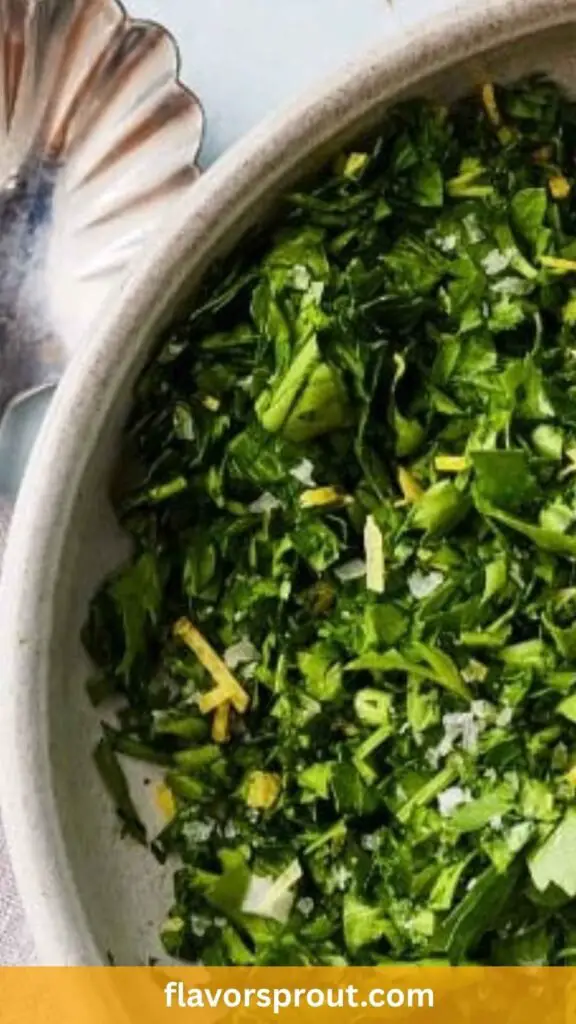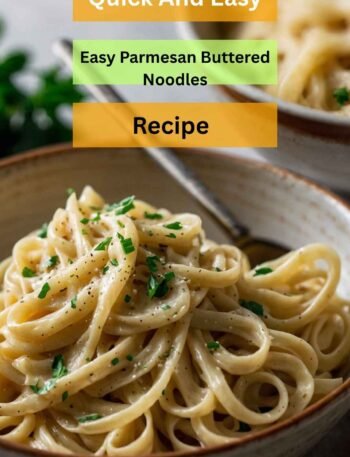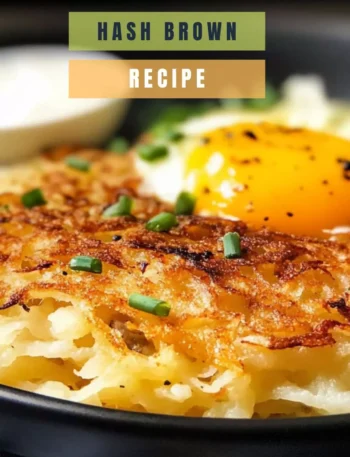A warm summer evening, the sun setting in the distance, and a delicious dish cooling on the table. Gremolata can be a game changer here. This vibrant mix of herbs and lemon can elevate everything from grilled meats, to roasted vegetables, and seafood.
A juicy piece of grilled steak, drizzled with a spoonful of fresh gremolata. It’s a match made in culinary heaven. Or consider mixing it into risotto for a zesty twist. Yes, the possibilities are endless, and trust me, your taste buds will thank you.

You’ll Also Like These Recipes
- How to MakeTrader Joe’s Garlic Spread
- Trader Joe’s Coconut Chocolate Date Bar
- Trader Joe’s Cocoa Powder Hot Chocolate
Let me take you on a journey into the delightful world of gremolata. If you’ve never encountered it, or only seen it sitting obediently next to a dish at a fancy restaurant, you’re in for a treat.
Gremolata may seem simple: a few fresh ingredients coming together in a bright-green paste. However, this traditional Italian condiment holds a heritage that’s as rich as its flavor. It is adaptable, refreshing, and can be made in a matter of minutes.
Making gremolata is an adventure worth taking. Each batch can be a little different—infused with your personality and preferences. Trust me; after you taste it, you will be eager to share it with family and friends.
Are you ready to dive into this flavorful condiment? Let’s explore what makes gremolata a standout in the culinary realm.
What is Gremolata?
Gremolata originates from Italy, specifically connected to the city of Milan. Traditionally featured alongside the braised veal dish known as Ossobuco, gremolata brings freshness and brightness, perfectly complementing the rich flavors of the meat.
At its core, gremolata is a blend of finely chopped parsley, garlic, and lemon zest. But don’t get too hung up on tradition.
This recipe allows personal flair. Variations tweak the ingredients to include herbs like mint or basil, adding layers of flavor. The idea here is to create something fresh that takes your dish from ordinary to extraordinary.
What is the Flavor Profile of This Dish?
When you first taste gremolata, the bright flavor of lemon catches your attention. Zesty, sharp, and invigorating, it dances around your palate (not literally, but you get my drift). The fresh parsley provides a herby green note that balances the punch of garlic. Then there’s a subtle earthiness from the extra-virgin olive oil, rounding out the flavors.
The balance in gremolata makes it versatile. It enhances roasted vegetables, enlivens seafood, and can even elevate a simple sandwich or pasta dish. Once you mix it in, you’ll immediately notice the difference. It’s like adding a splash of sunshine to your meal.
What Makes This Recipe Different From Other Gremolata?
This recipe is special because it goes beyond the classic version. While the standard includes just parsley, garlic, and lemon zest, I have added a hint of mint. That fresh flavor adds a delightful twist that many people don’t expect.
Each bite carries the tanginess of lemon along with the refreshing burst of mint, making it memorable.
The ratio of each ingredient is also key. It’s not just a sprinkle or a dash; it’s about creating a harmonious blend where no single flavor overpowers another. This balance invites curiosity, making the dish standout.
Ingredients You’ll Need
To whip up a vibrant batch of gremolata, gather the following ingredients:
- 2 teaspoons grated lemon peel
- 1 teaspoon finely chopped fresh mint leaves
- 1 small garlic clove, finely grated
- 1 bunch fresh flat-leaf parsley, finely minced (about ¾ cup)
- 1 teaspoon extra-virgin olive oil
- A pinch of sea salt (⅛ teaspoon)
These ingredients are relatively easy to find, ensuring you can create a bright and zesty condiment without a trek to specialty stores.

Step by Step Directions
Step 1: Gather Your Ingredients
Make sure all the ingredients are prepped. Rinse that parsley and mint and appreciate its fresh aroma. Get out your trusty knife and cutting board. A big bowl should be nearby, ready to hold this flavorful concoction.
Step 2: Chop the Herbs
Begin by finely mincing the parsley. Remove any tough stems. Remember, the finer the chop, the better the gremolata will blend together. Next, do the same with the mint leaves. The scent is phenomenal; you will love this.
Step 3: Grate the Lemon
Using a microplane, gently grate the zest from the lemon. Just the bright yellow part, not the white pith, as it’s bitter. The zing from the zest adds that sought-after freshness.
Step 4: Prepare the Garlic
Take that small garlic clove, remove the skin, and finely grate it as well. Garlic can sometimes be overpowering, but this method distributes it evenly throughout, creating a balanced flavor.
Step 5: Mix It All Together
In your big bowl, combine the minced parsley, mint, lemon zest, and grated garlic. Add a splash of the extra-virgin olive oil and the pinch of sea salt. Use a spoon to mix everything together until it forms a cohesive blend.
Step 6: Taste and Adjust
Here comes the fun part: taste-testing! If you feel it needs more lemon, add a pinch more zest. Love garlic? Go ahead and add a touch more. Adjust to your liking, and be creative!
Tips on Making Gremolata
- Use Fresh Ingredients: Fresh herbs and lemons make a significant difference. Dried herbs won’t yield the same vibrant taste.
- Chop Finely: The finer the herbs are chopped, the more integrated the flavors will be. Think of it as crafting a harmony of flavors.
- Experiment with Zest: Add zest from oranges or limes for a different fragrant experience. They’ll add a nice twist.
- Storage Matters: Store in an airtight container in the fridge for freshness. It can last a week if stored correctly.
- Use It Creatively: Don’t limit gremolata to just one dish. Try it on everything from grilled chicken to as a dressing for salads.
Nutrition Information
Gremolata Nutrition Facts
How Can I Store This Gremolata?
To keep your gremolata fresh, store it in a glass jar with a lid. Refrigeration is essential. Ensure you press the mixture down to eliminate air pockets since oxygen can cause herbs to oxidize. Properly stored, fresh gremolata can stay vibrant for up to a week. Just give it a stir before using to revive those flavors.

Substitute Options for the Ingredients
Sometimes, you may not have all the ingredients at hand. No sweat! Here are some substitutes:
- Parsley: If you lack fresh parsley, consider using cilantro. It offers a different flavor but maintains a fresh herbaceous note.
- Mint: No mint? Use a bit of basil instead. It can add a slightly different yet pleasing flavor profile.
- Lemon Zest: If you don’t have a lemon, try using lime zest. The tartness will still bring that citrus flair.
- Garlic: No fresh garlic? A dash of garlic powder can work in a pinch, but use sparingly—it’s much stronger than fresh.

Gremolata
Equipment
- Bowl
Ingredients
- 2 teaspoons grated lemon peel
- 1 teaspoon finely chopped fresh mint leaves
- 1 small garlic clove finely grated
- 1 bunch fresh flat-leaf parsley finely minced (about ¾ cup)
- 1 teaspoon extra-virgin olive oil
- A pinch of sea salt ⅛ teaspoon
Instructions
Step 1: Gather Your Ingredients
- Make sure all the ingredients are prepped. Rinse that parsley and mint and appreciate its fresh aroma. Get out your trusty knife and cutting board. A big bowl should be nearby, ready to hold this flavorful concoction.
Step 2: Chop the Herbs
- Begin by finely mincing the parsley. Remove any tough stems. Remember, the finer the chop, the better the gremolata will blend together. Next, do the same with the mint leaves. The scent is phenomenal; you will love this.
Step 3: Grate the Lemon
- Using a microplane, gently grate the zest from the lemon. Just the bright yellow part, not the white pith, as it’s bitter. The zing from the zest adds that sought-after freshness.
Step 4: Prepare the Garlic
- Take that small garlic clove, remove the skin, and finely grate it as well. Garlic can sometimes be overpowering, but this method distributes it evenly throughout, creating a balanced flavor.
Step 5: Mix It All Together
- In your big bowl, combine the minced parsley, mint, lemon zest, and grated garlic. Add a splash of the extra-virgin olive oil and the pinch of sea salt. Use a spoon to mix everything together until it forms a cohesive blend.
Step 6: Taste and Adjust
- Here comes the fun part: taste-testing! If you feel it needs more lemon, add a pinch more zest. Love garlic? Go ahead and add a touch more. Adjust to your liking, and be creative!
Notes
- Use Fresh Ingredients: Fresh herbs and lemons make a significant difference. Dried herbs won’t yield the same vibrant taste.
- Chop Finely: The finer the herbs are chopped, the more integrated the flavors will be. Think of it as crafting a harmony of flavors.
- Experiment with Zest: Add zest from oranges or limes for a different fragrant experience. They’ll add a nice twist.
- Storage Matters: Store in an airtight container in the fridge for freshness. It can last a week if stored correctly.
- Use It Creatively: Don’t limit gremolata to just one dish. Try it on everything from grilled chicken to as a dressing for salads.
Nutrition
Frequently Asked Questions
Q1: Can I make gremolata ahead of time?
Absolutely! You can make gremolata a day ahead. It might even taste better as the flavors meld together in the fridge.
Q2: What dishes can I pair with gremolata?
Gremolata works wonders with grilled meats, fish, roasted vegetables, and pasta. It’s also fantastic on crostini or stirred into dressings.
Q3: Can I freeze gremolata?
Yes, you can freeze gremolata! Place it in ice cube trays, and once frozen, transfer it to a freezer bag. Just pop a cube into your dish for instant flavor.
Q4: How do I use gremolata in cooking?
Mix it into sauces, sprinkle it on top of meats, or fold it into risottos. The possibilities are endless. Let your creativity run wild!
Q5: Is gremolata vegan-friendly?
Yes! Gremolata is an entirely plant-based condiment, making it suitable for vegans or anyone looking for a healthy, fresh addition.
Conclusion
Gremolata is far more than just a garnish; it can completely transform your meals. This simple yet powerful condiment showcases the beauty of fresh ingredients, giving life to an assortment of dishes. With its easy preparation and vibrant flavors, it’s an asset in any kitchen.
Whether you enjoy it on pasta, meats, or veggies, it brings a unique zing that keeps people coming back for more. You don’t just add gremolata; you enhance the whole dining experience.
So, grab those fresh ingredients, channel your inner chef, and give your meals that extra kick. Your taste buds are waiting for this refreshing adventure, and trust me, once you start using gremolata, it’ll become a staple in your culinary repertoire. Enjoy!




